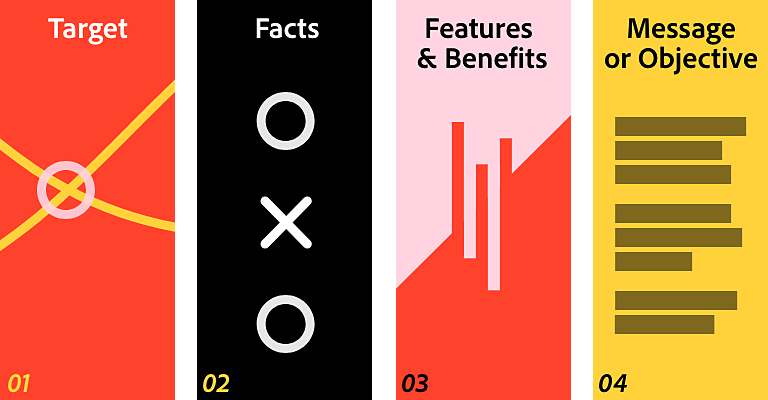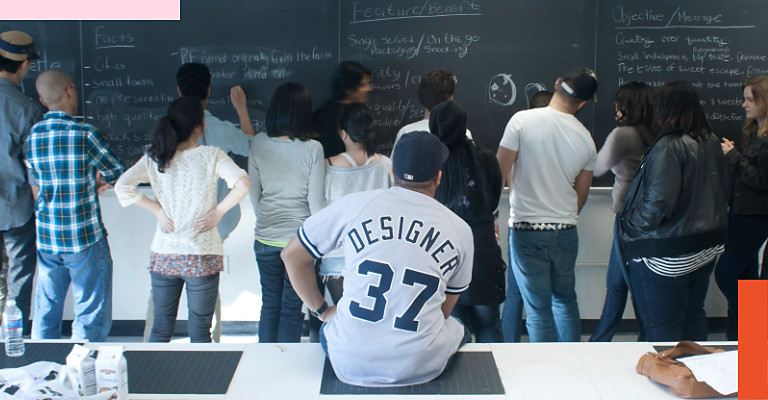impact with the Creative Strategy Framework.

Douglas Davis was a student in a competitive strategy class in NYU’s integrated marketing program when the professor held out a whiteboard marker and dared anyone to step up to the board. As an art director coming from a creative background, Davis often felt like a fish out of water in the competitive environment of business school — but in this moment, he suddenly found confidence and clarity.
He grasped the marker and drew four columns, articulating for the first time as he drew what he would later call the Creative Strategy Framework — a tool to help creative leaders think and speak like business leaders so they can communicate their ideas and drive business impact.
A decade later, Davis has written a book based on that framework — Creative Strategy and the Business of Design — and he has taught it to thousands of people around the world, from students to creative directors.
“I love being able to walk creatives through it because there’s so much fear,” says Davis, a professor at New York City College of Technology and chief strategist and principal designer at the Davis Group, LLC. “You’re an artist, and you walk into a business meeting with ideas you put your heart and soul into, but they’re going to get killed if you don’t walk in with the right strategy.”
The Creative Strategy Framework gets business leaders and creative leaders on the same page, Davis says, enabling an alignment that results in creative solutions to business problems.
The framework’s four columns — target, facts, features and benefits, and message or objective — represent four types of information creative professionals should gather as they approach a project. This article will walk through exactly how it works, including three steps to using the framework to help creative professionals produce work with greater business value.

Apply the four-part framework.
Let’s say you work for a low-cost airline that’s trying to get customers back in the air as the pandemic eases and travel becomes more possible. Your task is to develop a creative campaign that encourages people to overcome their fears and buy a plane ticket. Using the Creative Strategy Framework, you would begin by collecting information in each of the four areas.
1. Identify the target audience.
The airline likely serves several types of customers — for example, business travelers, tourists who are tired of sitting at home, or people with children looking to reconnect with family. List each audience along with their problems or pain points in the first column of the framework.
“My first step would be to try to understand the people,” Davis says. “We’ve been trained to see the problem from the viewpoint of the brand, but the real question is, what is the target’s problem and how can I understand it so I can align it with a solution?”
Davis recommends writing down details about who you’re talking to, what they need, what their fears or barriers are, and how those could be neutralized. In the case of the airline, if you were listing pain points for families, you might include needs such as wanting to see grandparents they haven’t seen in a long time, fears such as becoming infected, and barriers such as the cost of traveling with kids.
2. Collect as many facts as you can.
The second column of the framework is for facts about the brand, product, or service — including as much internal and external data as you can find. In the airline category, that means things like internal information about how much sales declined in the last year — a business problem that company leaders are trying to solve. It also means secondary research on industry trends, competitors, and the company’s position relative to them, as well as any current travel advisories. Customer reviews can shed light on pain points and public perceptions, and the 10-K statement in SEC filings outlines risks to the company and provides important business context.
“I’m looking at everything,” Davis says. “You have to dig deep and go beyond what the brand says about itself, or you’re just going to come up with a message that works internally but not externally.”
The point of this part of the Creative Strategy Framework, Davis says, is to collect nuggets of information that you can then use to draw connections and spark big ideas. “If you find insights through research that others aren’t looking for, you’ll come up with something others can’t because it’s not on their radar."
3. Connect features and benefits.
Use column 3 to list features (particular aspects of your product or service) and benefits (the positive impacts of those features on the target).
For example, a low-cost airline might offer various fare classes (a feature) for customers who want to save money (a benefit) by forgoing things like extra legroom or free Wi-Fi. Or for a little extra money, the airline might introduce earlier boarding and contactless check-in (feature) for those who want to feel safer (benefit).
You might notice that the benefits are closely related to the pain points listed in column 1, and that’s intentional. “This is why we had to start with the target,” says Davis. “We have to understand what moves them. What exactly are they trying to get from travel? Is it rest and relaxation? Mental health? Family ties? All of that is going to help me choose — do I lead with a feature statement or do I talk to them about the benefits?... I think the traveler who’s going for rest and relaxation is looking for the benefits. The price-sensitive traveler is looking for features."
4. Formulate your message or objective.
This column brings together all the information you’ve collected. Looking at the business problem, the competition, and the framework so far, begin to articulate the message you want the customer to come away with after seeing your creative work. Davis says not to worry about being clever at this stage — just say it straight.
In the airline example, if your target is families, your objective might be for them to understand the following message (note the pain points, features, and benefits included):
“As a company of mothers, fathers, sisters, and brothers, we share your values. We believe people should be connected, and we provide affordable solutions that can get your family safely from point A to B and back again."

Twisting the Rubik’s Cube.
Successfully using the framework involves three steps, Davis says. The first is quantity — gathering as much information as possible. The second is quality — whittling down to the most relevant and useful information. The third is strategic insights — using the framework to connect the dots and yield thought starters as you brainstorm your creative campaign.
“If you don’t uncover new insights, you’re coming up with executions that either have been done before, probably won’t work, or are definitely not high-level concepts,” Davis says. “The way to uncover insights is to exhaust the columns and look for the completely unexpected connections that emerge across categories because you’re looking at all the information in a new way.”
He adds, “I love this part because you can twist that Rubik’s Cube in a way that nobody else is twisting it.”
The final step is presenting your ideas to business leaders — and the Creative Strategy Framework helps you approach that conversation, too. The template for talking about creative work in the context of business objectives is based on the four columns:
“Based on [the target’s] need or behavior, let’s start a conversation centered around this [fact] or truth using this [feature or benefit] in any headline or copy to deliver this [message] or accomplish this [objective].”
Weaving strategy into your execution transforms you into a partner in driving business impact, Davis says. “As creatives, we aren’t just execution-focused. We’re also focused on solving the business problem. This is about creative business solutions — it’s bigger than just making things pretty.”
For more insights from Davis on creative strategy, check out our video series, The 5-Minute Creative Mentor. Watch Episode 1: The Creative Strategy Framework below, then explore Episode 2 on writing creative briefs and Episode 3 on perfecting creative pitches.
Adobe can help.
Adobe Creative Cloud for teams gives you the world’s best creative apps and services in a single, secure, integrated platform. With 20+ desktop and mobile apps, Creative Cloud Libraries for keeping assets in sync across apps and devices, and 1TB of storage per user, this complete creative software solution is designed to support your business at every stage of growth. Plus, you can count on simplified license management and total control over your software to help your team stay focused on creating great work.
?$png$&jpegSize=100&wid=155)
socialFollowingVideo
socialFollowingVideo